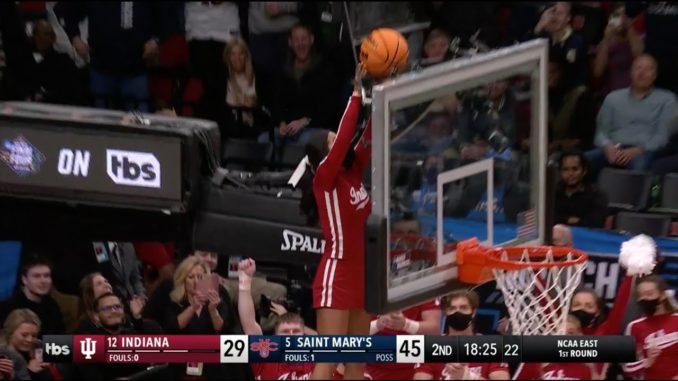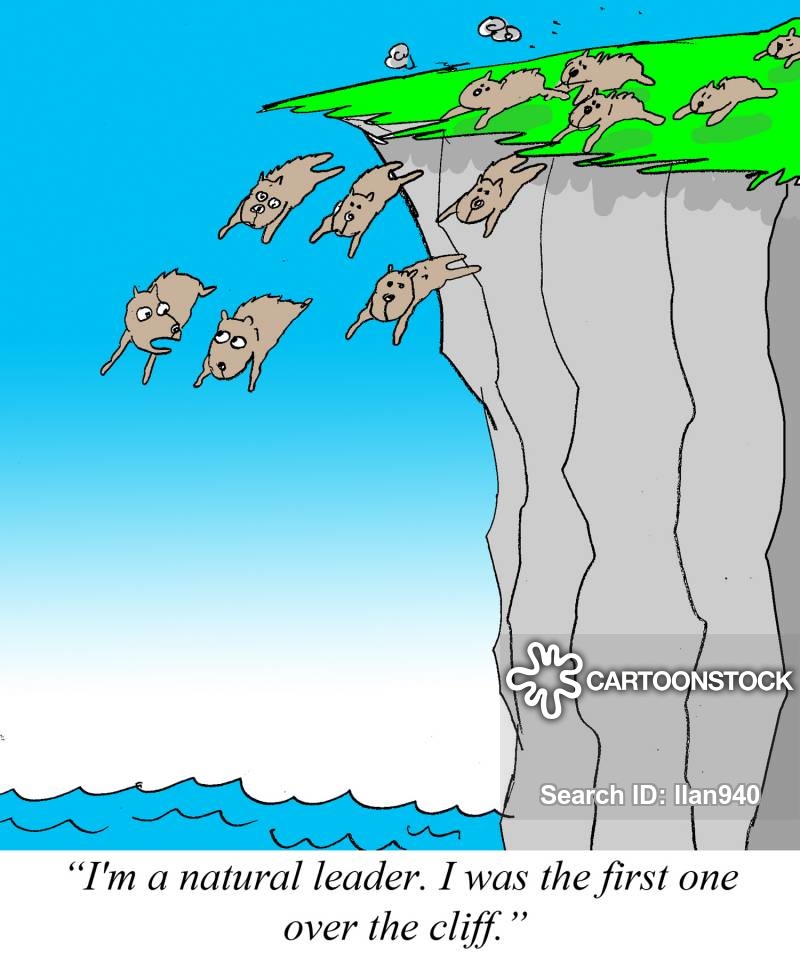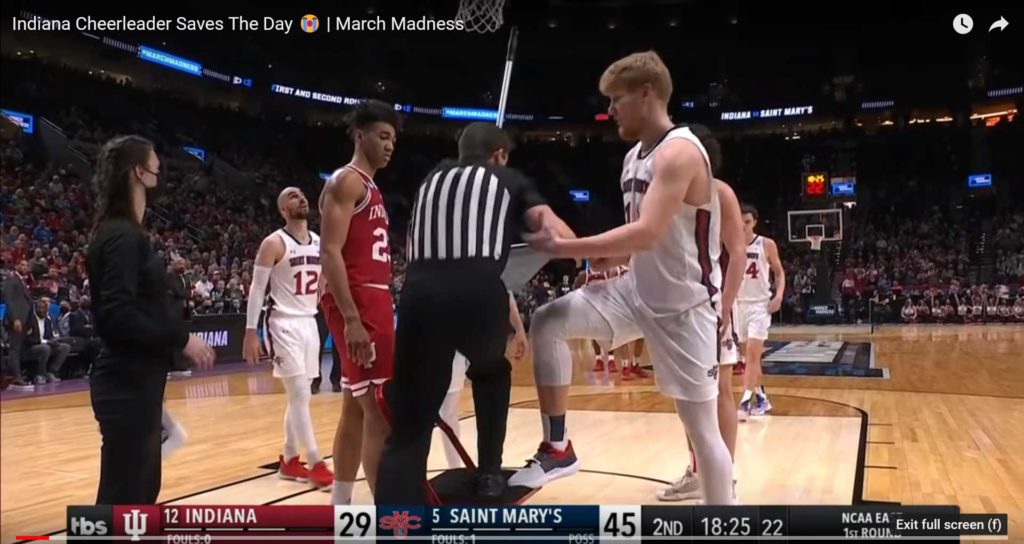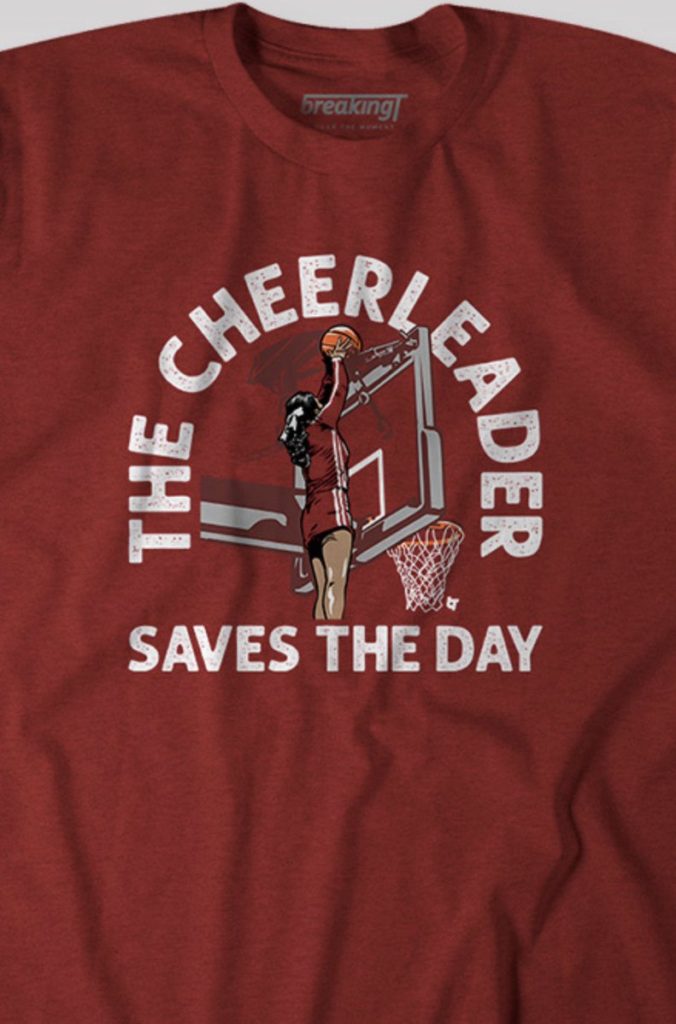
The first four days of March Madness is the single greatest four-day-weekend in modern times. It has everything a reporter, casual fan, extreme fanatic, gambler, player and college could ask for. In sports and life. This year, however, brought us an extra reminder how easily we humans engage in Herd Mentality. And enable unaccountable apathy.
First off all, let’s be clear that Indiana Spirit Squad March Madness Moment was nothing short of an awesome, organic inspiring moment that showcased intellectual ingenuity, talent and teamwork.
Second, like a lead singer in a band, the cheerleader gets all the media attention for a group’s efforts and talents. Keep in mind, this isn’t a slight on the Indiana Cheerleader, no, it’s a slight on the media and how apathetic they have become with their reporting and details.
Hey, who invited Captain BuzzKill to March Madness? I thought this was about Cheerleaders. OK, let’s start percolating positivity and get to those three cheers!
The first cheer is for all the people who were thinking outside the box of regulations, modern-day hall monitors and Political Correctness Police by allowing the Spirit Squad to inspire millions.
The second cheer is for all those in appointed authority allowing a group of new people outside their network to take a chance with new collective talents, skills and innovative ideas.
The third cheer is for the Arkansas Spirit Squad who reminded us all once again how many people with appointed power in government can become apathetic to the point it triggers a herd mentality without anyone even realizing it.
Well, ESG University noticed it and has a few questions for the March Madness Rulers and Regulators.
Before I dive too deep into the Madness, let’s start at the beginning and look up the phrase “herd mentality”.
Definition of Herd Mentality – Merriam-Webster
: the tendency of the people in a group to think and behave in ways that conform with others in the group rather than as individuals
I.e. – Stock investors, riveted by recent market gyrations, need to resist emotional responses and the herd mentality when investing
Interesting that Merriam-Webster’s example is related to investing and the stock market. And if I keep reading, it says the first known use was in 1920. My North Dakota State University education disagrees with Merriam-Webster actually, so we are at our first Teachable Moment in today’s Classroom Column. Merriam-Webster is often cited as the “official” source for information, but not by me. Nope, Merriam-Webster was appointed by others in power.
By my memory “herd mentality” was first documented in France, not the American stock market. That may have been the first time it was used in America, but in France, they were studying this social behavior in the 19th Century.
That’s the type of dialectal disagreements with the Word Authority Folk of Merriam-Webster that makes me want to Wiki this. It’s like a metaphorical March Madness Match Up of Appointed Leadership versus The People. The Pronoun versus the Word-A-NESTA.
Wiki says it was 19th-century social psychologists Gabriel Tarde and Gustave Le Bon who studied this mass psychology and behavior. The people of Wiki have spoken so I am siding with their information over Marriam-Webster on this one. Like most, I pick and choose winners too. This time Wiki suits my point better so it’s the power of the people and pronouns. Hey, ESG it all about transparency folks, even with the professor.
As long as I am on Wiki.
Definition of Herd Mentality – Wikipedia
Herd mentality, mob mentality or pack mentality describes how people can be influenced by their peers to adopt certain behaviors on a largely emotional, rather than rational, basis. When individuals are affected by mob mentality, they may make different decisions than they would have individually.
Social psychologists study the related topics of group intelligence, crowd wisdom, groupthink, and deindividuation.
Any questions on what Herd Mentality is? Sometimes it is referred to as a group of Lemmings and there is even a story about a Pied Piper too with similar themes.

If you want to dive into the deep Madness, do a MindHunter Flow Chart of the American Origin of Herd Mentality and one could (and does) argue it led to the formation of the Federal Reserve in 1913 and the Stock Market Crash of 1929. Both of these historic events were created by Herd Mentality with a permanent solution for your life. A permanent solution that was created by a group of appointed leaders you don’t know and have zero interest in your family’s interests, nope, only your financial interest.
For this Classroom Column exercise in critical thinking, we will use a visual aid from the YouTube. Please take a moment and watch this video clip of the first Spirit Squad (Indiana University) who inspired millions with their March Madness Moment.

Let’s dissect this with a little authoritative accountability sprinkled in for good measure.
The first attempt at retrieving the basketball from the top of the backboard was from the tallest guy on the court using a broomstick, with a large duster swath still attached. This was the low hanging fruit leadership there. This is entry-level-eyeball leadership that is akin to putting the square peg in the square hole leadership-challenge-level. And it often works in everyday life. Easy peasy, lemon squeezy.
Unfortunately it didn’t work. On live television. Which makes the second attempt much more interesting. Comically interesting.
Seriously, it really does become comical when you watch the video and the referee gets the chair. Plus the girl with the broomstick is trying to remove the giant duster swath in the background as people kind of frantically meander around.
If there was fast-paced British music it would have been a scene from Benny Hill. And can I get three cheers for the Announcer who sold that moment better than an announcer at WrestleMania. Seriously, that was amazing and inspiring in itself. Welcome to the Madness Brotha.

Then comes that One Shining Moment in leadership. The moment the referee shows he’s out of his authority element. And it wasn’t his fault, he obviously wasn’t trained on the proper procedures and protocols for retrieving a lodged ball from the top of a backboard during a national televised game with millions of dollars of advertising buys depended on proper game flow. But someone was in charge of that.
Not this ref, however, it was obvious in the way he was making definitive decisions on the court while the world was watching. In a very seamless, but noticeable moment, the referee is faced with a split second decision moment of political correctness and real time reality.
Since the first attempt to use the tallest guy with the closest, longest stick you can find didn’t work, let’s add about a foot of height with a chair. Except for one problem, the solution with limited resources within the invisible walls of political correctness, didn’t get the ball down.
Rather, they replaced the 7-foot center with a 5-foot-something referee and chair. I didn’t measure the people involved, nor did I look up the chair’s math, but my eyeball algebra test wonders if they gained any height from Chair plus Ref or did they lose height from the 7-footer plus broomstick?
You see the student athlete couldn’t step up on a chair that is meant for sitting while on national television with every cell phone in the stands streaming. He may have slipped and fell. Or worse yet, someone watching could have Tweeted that thought or shared their negative horror movie plot fear on social media from seeing a college kid stand on a chair. Without a mask.
Seriously when the ref started stacking things on the chair it was the making of a Saturday Night Live skit starring the cast of Looney Tunes or Scooby Doo.
The Cheerleader Saves The Day video does show how difficult it is for a leader to lead in today’s moment. When the referee stood on the chair and reached up with the broom and the sequence of events leading up to it literally made me laugh out loud in the moment. I hadn’t laughed like that since I was a child watching the great escape by stacking a chair on top of the table on top of the books and on the top is the wobbling candlestick. It was a Loony Tunes March Madness Moment.
The day after the first cheerleader was used in order to retrieve the ball on top of the backboard, Executive Coach Joe Sinnott of Witting Partners and I discussed how her moment was a lesson for us all.
Sinnott and I had a good laugh recapping that moment on how much of today’s leadership seems to be doing this same formula with energy.
“That’s a great visual Jason. Take that March Madness chair stacking leadership into renewables and you can see the wonky foundation of stacking a wind turbine with a solar panel, an EV Car and so forth,” Sinnott said. “If it’s not already a meme, it should be.”
Sinnott’s right. It should be. If not for humor sake, for reality reasons. My reality from the Cheerleader March Madness Moment is not singular, no it’s layered with emotion.
I was shocked, then confused, then entertained, then bewildered, then curious, then a little empathically embarrassed, then searching for answers to their problem, to then agreeing with the momentum of the people projecting the Solution of the Spirit Squad, to then engaging with the existential energy to literally standing up while raising my arms up in the air like a referee signaling a touchdown.
I may have left out a couple emotions in what the media continues to try to convince me was only One Magic Moment. Nope there were many reasons and emotions tied to that March Madness moment. But if I had to sum it up in one word it would be Inspiring.
That moment was inspiring for so many reasons. People cheered at that moment for the Spirit Squad’s ingenuity. People were inspired because true talent shined. People shared that moment because it connected with people in a new yet familiar way. It connected with The People because it was the people solving the problem.
Here’s where this ESG University Classroom Column gets into the ESG. Did anyone come up with a new plan in case this happens again? There are actually people who are paid a lot of public money in leadership to work on these types of plans. I know there have been meetings, we’ve all seen the social media posts from the appointed leaders with the catered meals and group pics highlighting how they are the solution to our social issues.
Furthermore, there are people getting paid lots of public money to make sure safe and healthy policies are kept accountable. Since the opening round of March Madness, there has been a week for the group of Appointed Leaders to figure out a safe, reliable way to get a ball down from a backboard.
Did they work this week on a new guideline to prevent millions of dollars to be impacted by a delay of game from the ball being stuck on the backboard? Nope, it’s March Madness week, so that group of appointed leaders have parties to attend and other social functions to promote on social media. Plus there’s the social media social issue of the day to be socially aware of. Oh and let’s not forget about the Ice Cream Social.
One has to seriously wonder if the new approved policy by the NCAA for getting a ball off the backboard or scoring clock is now “spirit squad” because the people cheered for it and it was cool.
Many of you might be thinking Captain BuzzKill has returned, but check out what happened a week later during the Arkansas Duke game.

This time a Spirit Squad from Arkansas saved the day and Millions in March Madness Marketing Monies. Wait, it was Duke and Mike Krzyzewski’s farewell tour… billions of marketing dollars at stake in that game.
It was another Spirit Squad, led by a lead singer cheerleader, that became the solution to a billion dollar problem. The nameless, faceless power of the people solved the recurring problem for the nameless faceless appointed leadership.
The two March Madness cheerleader and spirit squad moments quite possibly could teach us more about human nature and ESG than anything else. If you were to boil down the dollars and sense, you would find there is a budget amount and plan for getting a ball down from the backboard.
Did the cheerleader get paid by the NCAA? Did the spirit squad? Did the people who are paid to prevent these issues from happening even know that two spirit squads did their job for free?
What makes this story even more fascinating is the amount of wasted money, time and resources our government continues to enable. Let me dive deeper into this G portion of the ESG Madness.
The original cheerleader from Indiana has a name, it’s Cassidy Cerny. How many of you knew this? My guess is less than 1%. I didn’t. I had to look it up. And even then I had to click on the headline and read a paragraph or two into the story to find her name. That’s how important her individual identity is in this story to all the media outlets.
If Kim Kardashian or Julia Roberts would have gotten the ball down, their name would be the headline, not the word “cheerleader”, “celebrity” or “actress”.
You see, a basic “cheerleader” connects more than the individuality of “Cassidy”. Focusing on one person is easier than a whole bunch of people in a group, so the media and authority’s laziness continues to enable our social issues. See how I quickly threw a “S” in there?
Now comes the “E”. Entertainment. The only real opportunity Cassidy has to get paid from her labors. I doubt she will be hired as a safety consultant or whatever corporate job is responsible for getting a ball down from the backboard.
Cassidy’s identity went into a Social Cocoon that day. She lost her name and became the March Madness Cheerleader or the Save The Day Cheerleader. Her identity took on a life of its own and is wrapping her tightly into a new person. Cassidy Cerny will never be the same again.
The ten to fifteen people supporting her by lifting her up and being a human net will not have the Social Cassidy Cocoon, no, they will only have a 15-minute of fame moment. Fifteen seconds actually. Cassidy will forever be the nameless faceless cheerleader linked to this moment.
You may be asking yourself once again what do the Cheerleaders in March Madness have to do with ESG? Or even energy? This Classroom Column says everything.
That 2-minute segment of leadership getting the ball down from the top of the backboard should be taught in more Universities than ESG U. Heck, we’d do an entire 400-level-class on that 2-minute moment.
Cassidy did get paid by the way. But not by the government, NCAA Sports or the educational administration system. Nope someone in the private sector with private sector money is taking a gamble on her March Madness Moment with a T-Shirt deal.
The company taking the risk is Breaking T and a T-shirt has been designed to commemorate the moment Cassidy retrieved the ball from the backboard with the shirt caption reading “The cheerleader saves the day.”
The snarky barstool banterer inside me would even suggest that the taxes from Cassidy’s new opportunity will continue to fund the appointed authority’s apathy too. Cassidy keeps working while the others keep posting social media pics showing the world how they are the ones officially solving the problems in our lives. But that’s the snarky side of my Libra mind. Let’s let that old-man-shouting-at-clouds moment just die right here on the vine, I want some more March Magical Madness and wrap up this thought exercise!
In conclusion, while many of you who are reading this Classroom Column will go to Merriam-Webster or Wikipedia for your answers and definitions in life, remember this. There are social scientists of the intangible areas of life who create their own magical moments of critical thinking. These people are often given titles of educators, philosophers and psychologists, however, I would throw comedians in there too.
Personally, I consider George Carlin, Chris Rock and Dave Chappelle more as prophets and philosophers than as comedians. Just because they use humor and related context rather than boring book stuff doesn’t mean their message lacks meaning or substance. Usually it’s the receiver of the message who doesn’t have mental freedom to allow their mind to go where Carlin, Chappell and Rock go.
As one last reminder of our Herd Mentality as a species, consider these words from the Great Philosopher David Chappelle:
“I just want you guys to remember that right now, there’s this thing where ethics aren’t what it used to be. This idea that people are trying to replace the ideas of good and bad with better or worse. And that is INCORRECT.
You gotta keep your ethics intact because good and bad is a compass that helps you find a way. A person that only does what’s better or worse is the EASIEST type of person to control. They are a mouse in a maze that just finds the cheese. But the one who knows about good and bad will realize that he is in a maze.
It’s ok to be afraid because you can’t be brave or courageous without fear. The idea of being courageous is that even though you’re scared, you just do the right thing anyway.”
And that’s the end result. Let’s not allow the Media’s Lazy Yet Bullish Herd Mentality to trick you into thinking it was a single Cheerleader who did this amazing March Madness Moment. No, it took the Herd Mentality of the People to persuade the Herd Mentality of Appointed Authority. And it wasn’t just the Cheerleader who got the ball down, no, it was a team and group of spirited supporters who literally lifted one person up to achieve a single goal that benefited millions people all over the world.
It was the collective energy from a group of spirited supporters lifting up one person to achieve a single goal to benefit millions of people all over the world.
Wow. That’s an inspiring magical moment there folks.
Class dismissed til next week.
Questions on today’s lesson? Know someone using Ethical Energy? ESG University wants to know who these leaders are as we continue to showcase and highlight ESG solutions in energy. For consideration, please email studio@thecrudelife.com companies, people and organizations showing ESG in action.
ESG University Classroom Column is written by Jason Spiess and no way reflects the mission or position of his other media companies. ESG University is an educational paper with classic newspaper op/ed elements sprinkled in. Because of this, we must categorize the column as Opinion and Editorial and run this disclaimer.



